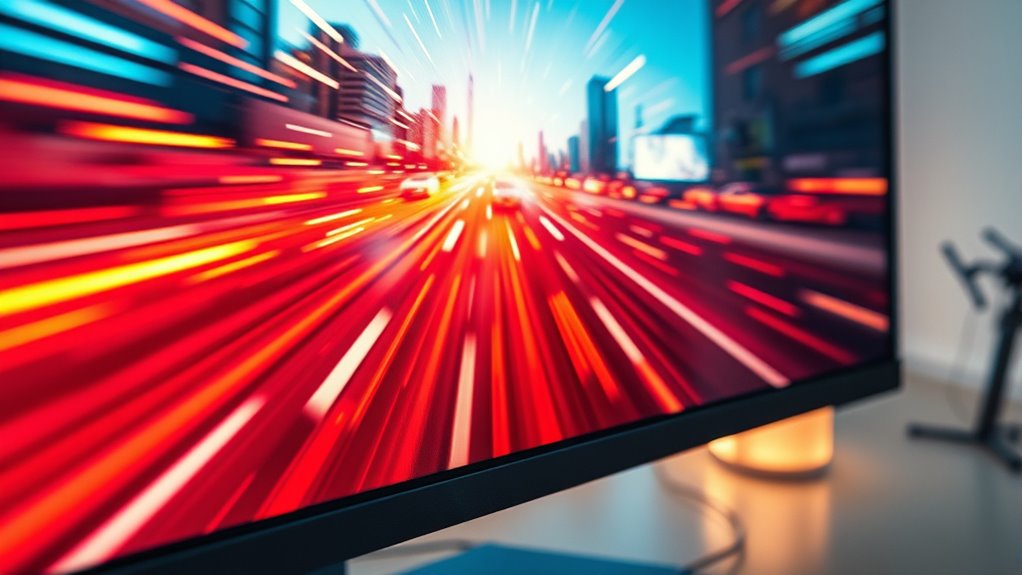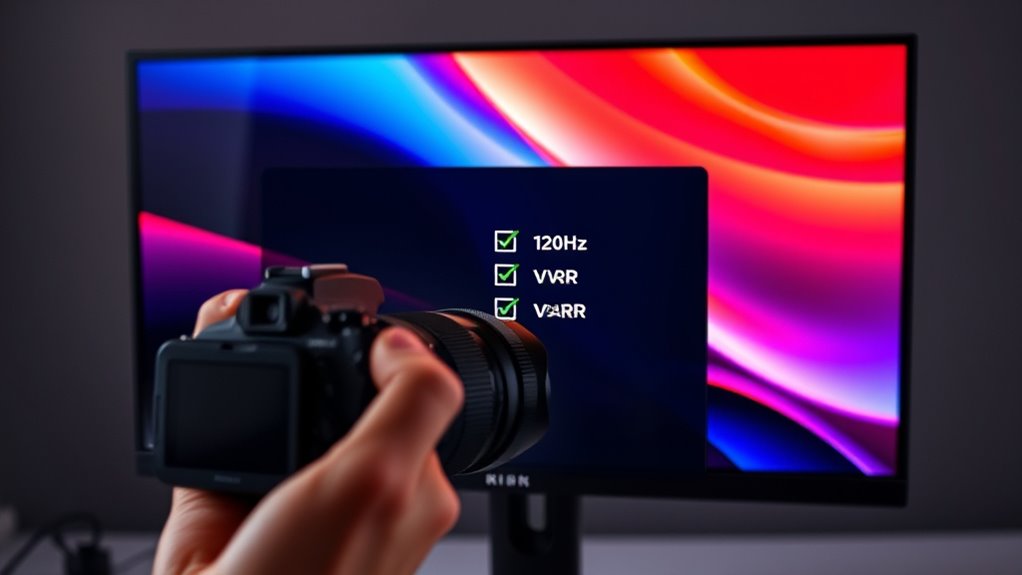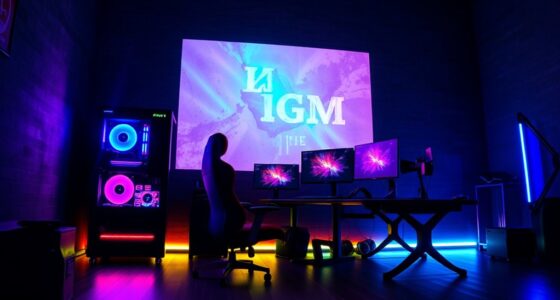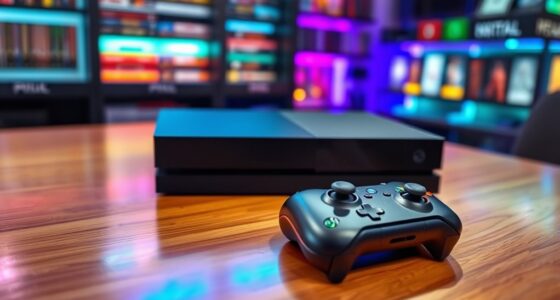Before you start, understand that a 120Hz refresh rate means your display updates 120 times per second, providing smoother visuals and better responsiveness. VRR technology like FreeSync or G-Sync dynamically adjusts the monitor’s refresh rate to match your GPU’s output, reducing tearing and stuttering. Confirm your monitor supports both features and your graphics card is compatible. Mastering these basics will help you optimize your gaming experience and get the most from your setup.
Key Takeaways
- Ensure your monitor supports both 120Hz refresh rate and compatible adaptive sync technology like FreeSync or G-Sync.
- Confirm your graphics card can output at 120Hz and is compatible with adaptive sync features.
- Adjust your display settings to enable 120Hz refresh rate and adaptive sync for optimal performance.
- Be aware that adaptive sync benefits are most noticeable during variable frame rates.
- Check for firmware or driver updates to ensure maximum compatibility and performance.
Understanding Refresh Rate and Adaptive Sync Basics

Before You Start
Before you start any project, it’s essential to lay a solid foundation. When it comes to gaming or high-performance displays, understanding the basics of refresh rate and adaptive sync is vital. These features directly influence your experience, making gameplay smoother and visuals more responsive. The refresh rate, measured in hertz (Hz), indicates how many times your monitor updates its image each second. A higher refresh rate, like 120Hz, means the display refreshes more frequently, resulting in less motion blur and a more fluid picture. If you’re aiming for fast-paced action or competitive gaming, a higher refresh rate can give you a tangible edge by reducing input lag and providing sharper visuals.
However, having a high refresh rate alone isn’t enough to guarantee seamless gameplay. That’s where adaptive sync technologies come into play. Adaptive sync dynamically matches your monitor’s refresh rate to your graphics card’s frame output, effectively eliminating screen tearing and minimizing stuttering. Traditional monitors can struggle with inconsistent frame delivery, which causes distracting visual artifacts. Adaptive sync, including technologies like FreeSync and G-Sync, smooths out these hiccups, letting you enjoy a more immersive experience. When your graphics card produces frames at a variable rate, adaptive sync adjusts the monitor’s refresh rate in real-time, maintaining synchronization and ensuring your gameplay remains fluid and responsive.
If you’re considering a 120Hz display, it’s important to confirm whether it supports adaptive sync. Not all high-refresh-rate monitors do, and pairing a 120Hz screen with adaptive sync can maximize your gaming performance. This combo helps you avoid frustrating issues like screen tearing during intense moments, especially when frame rates fluctuate. Keep in mind that to fully benefit from adaptive sync, your graphics card must support the technology as well. Most modern GPUs are compatible, but it’s worth double-checking specifications before making a purchase.
Getting familiar with these concepts before you start setting up your system saves you time and potential disappointment later. Knowing the importance of refresh rate and adaptive sync allows you to choose the right monitor based on your gaming needs and hardware capabilities. Whether you’re upgrading an existing setup or building a new one, prioritizing these features ensures you’ll get the most out of your investment. Remember, a high refresh rate combined with adaptive sync creates a smoother, more responsive experience—vital when every millisecond counts. By understanding these fundamentals upfront, you’re better equipped to select the right display and optimize your gameplay from the start. Additionally, understanding the impact of refresh rates can help you make informed decisions that enhance your overall gaming experience.
Frequently Asked Questions
How Does 120HZ Affect Battery Life on Portable Devices?
Using 120Hz can decrease your portable device’s battery life because it increases power consumption. Higher refresh rates demand more from your device’s GPU and display, which can drain the battery faster. Device compatibility matters here—if your device supports 120Hz, you might notice shorter usage times. To conserve battery, consider lowering the refresh rate when high performance isn’t needed, helping extend your device’s battery life.
Can VRR Improve Gaming Performance on All Consoles?
VRR can improve gaming performance on most consoles by reducing frame latency and input lag, providing smoother visuals and more responsive gameplay. However, it might not work perfectly with every game or console model, so your experience could vary. To get the best results, make certain your console and display support VRR and enable it in settings. This setup helps you enjoy more fluid, enjoyable gaming sessions.
Is Higher Refresh Rate Always Better for Every Type of Content?
Think of refresh rate as the heartbeat of your display; a higher rate can make motion smoother, but it’s not always better. For fast-paced gaming, it boosts responsiveness, yet for movies or static images, it might be overkill. Your content quality depends on matching the refresh rate to what you’re viewing—higher isn’t universal. Balance and purpose shape the best choice for your experience.
Do All TVS Support Both 120HZ and VRR Simultaneously?
Not all TVs support both 120Hz and VRR simultaneously. TV compatibility depends on the model and its adherence to refresh rate standards. Some TVs may offer 120Hz support but lack VRR, while others include both features. To guarantee you’re getting these capabilities together, check the specifications carefully. Higher-end models usually support both, making them ideal for smooth gaming and fast-moving content, but lower-end TVs might only support one or neither.
How Do I Enable 120HZ and VRR on My Monitor?
Think of your monitor as a dance partner; to sync perfectly, enable 120Hz refresh rate and adaptive sync. First, go to your display settings and select the highest refresh rate available. Then, access your monitor’s menu or graphics card control panel to turn on VRR or adaptive sync. This guarantees smooth gameplay, reducing tearing and lag, so your monitor and GPU dance in perfect harmony.
Conclusion
Now that you’re armed with the basics of 120Hz and VRR, you’re practically a display wizard! Remember, a higher refresh rate and adaptive sync can turn your gaming or viewing experience from good to mind-blowingly smooth — almost like teleporting into your favorite scene. So go ahead, tweak those settings, and enjoy buttery-smooth visuals that make every frame feel like a tiny masterpiece. Your eyes will thank you for this leap into the future!









